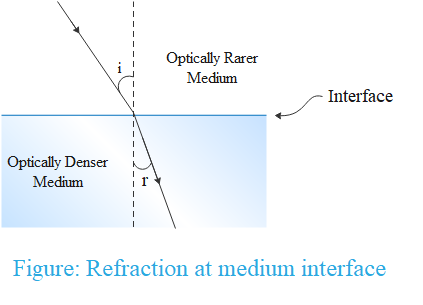
Change in the direction of propagation of light when it passes from one medium to another is called?
A. reflection
B. refraction
C. diffraction
D. scattering
Answer
531.6k+ views
Hint: Refraction of light is one of the commonly observed phenomena, but other waves like sound waves and water waves also experience refraction.
During refraction the frequency of the refracted ray remains constant; though speed of light changes on refraction.
Complete answer:
Reflection is defined as the change in direction of a wave at a surface boundary between two media so that the wave returns into the medium from which it originated.

When a wave travels from one medium to another, the change in its direction occurs. This phenomenon of change in direction of a wave passing from one medium to another is known as refraction.
Diffraction is a phenomenon that occurs when a wave falls on an obstacle of a size comparable to its wavelength. Due to diffraction, when waves pass around obstacles it spreads out or bend near its edges.
Scattering is defined as the phenomenon in which light rays get deviated from their straight path on striking an obstacle like dust or gas molecules, water vapours etc. The particles which scatter light are known as scatterers.
Since, Change in the direction of light when it passes from one medium to another is called refraction.
So, the correct answer is “Option B”.
Additional Information:
Interference is a phenomenon in which two waves superimpose to form a resultant wave of greater, smaller or the same amplitude. The amplitude of resultant waves depends on phase difference between the two waves.
Note:
The bending of a wave when it passes from one medium to another is known as refraction. This is caused due to differences in density between the two mediums.
The angle of refraction can be determined using Snell’s law which says, “ ratio of the sine of angle of incidence to the sine of the angle of refraction is a constant.”
During refraction the frequency of the refracted ray remains constant; though speed of light changes on refraction.
Complete answer:
Reflection is defined as the change in direction of a wave at a surface boundary between two media so that the wave returns into the medium from which it originated.

When a wave travels from one medium to another, the change in its direction occurs. This phenomenon of change in direction of a wave passing from one medium to another is known as refraction.
Diffraction is a phenomenon that occurs when a wave falls on an obstacle of a size comparable to its wavelength. Due to diffraction, when waves pass around obstacles it spreads out or bend near its edges.
Scattering is defined as the phenomenon in which light rays get deviated from their straight path on striking an obstacle like dust or gas molecules, water vapours etc. The particles which scatter light are known as scatterers.
Since, Change in the direction of light when it passes from one medium to another is called refraction.
So, the correct answer is “Option B”.
Additional Information:
Interference is a phenomenon in which two waves superimpose to form a resultant wave of greater, smaller or the same amplitude. The amplitude of resultant waves depends on phase difference between the two waves.
Note:
The bending of a wave when it passes from one medium to another is known as refraction. This is caused due to differences in density between the two mediums.
The angle of refraction can be determined using Snell’s law which says, “ ratio of the sine of angle of incidence to the sine of the angle of refraction is a constant.”
Recently Updated Pages
Master Class 12 Business Studies: Engaging Questions & Answers for Success

Master Class 12 Biology: Engaging Questions & Answers for Success

Master Class 12 Physics: Engaging Questions & Answers for Success

Class 12 Question and Answer - Your Ultimate Solutions Guide

Master Class 12 English: Engaging Questions & Answers for Success

Master Class 12 Economics: Engaging Questions & Answers for Success

Trending doubts
Which are the Top 10 Largest Countries of the World?

What is transplantation in agriculture class 12 biology CBSE

Differentiate between homogeneous and heterogeneous class 12 chemistry CBSE

Why is the cell called the structural and functional class 12 biology CBSE

Hydrological cycle is controlled by A Grasslands B class 12 biology CBSE

Who discovered the cell and how class 12 biology CBSE




